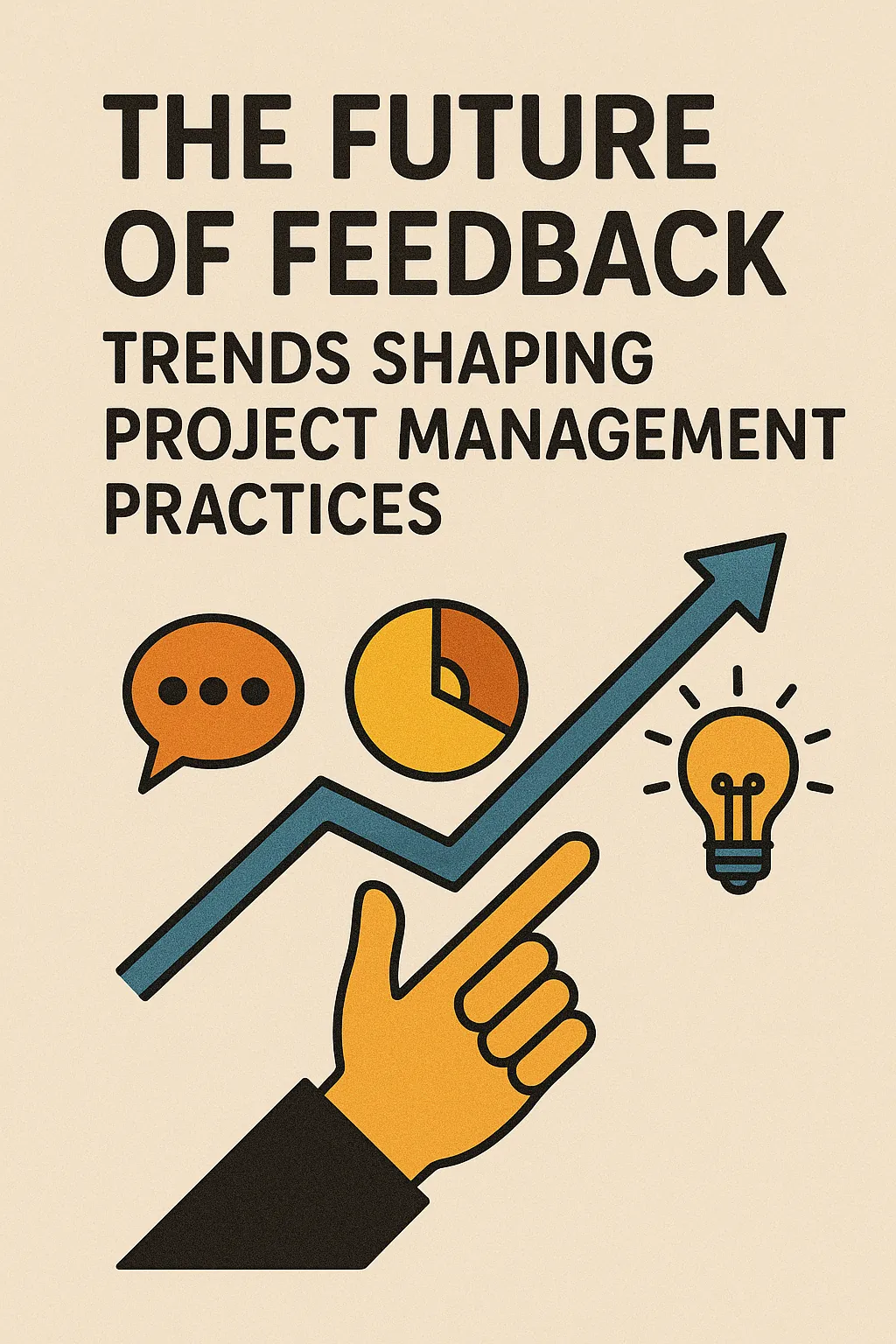The Future of Feedback: Trends Shaping Project Management Practices
Introduction
Feedback serves as a cornerstone for success, driving continuous improvement and fostering collaboration among team members. The importance of feedback cannot be overstated; it not only enhances team performance but also ensures that projects align with organizational goals and stakeholder expectations. As project managers navigate increasingly complex environments, the ability to provide and receive constructive feedback becomes essential for maintaining momentum and achieving desired outcomes.
As we look to the future, feedback mechanisms are poised to evolve significantly. Traditional methods, often characterized by periodic reviews and formal evaluations, are giving way to more agile and responsive approaches. This shift is driven by advancements in technology, the rise of remote and hybrid work models, and a growing emphasis on employee well-being and engagement. Forward-thinking project managers and leaders must adapt to these changes, embracing innovative feedback tools and practices that facilitate real-time communication and foster a culture of openness.
The relevance of these evolving feedback mechanisms is particularly pronounced for project managers who are committed to leading their teams effectively in an ever-changing environment. By staying attuned to emerging trends and integrating new feedback strategies, they can enhance team dynamics, improve project outcomes, and ultimately drive organizational success. As we delve deeper into the trends shaping the future of feedback in project management, it is crucial for leaders to recognize the transformative potential of these practices and their impact on project execution and team collaboration.
Current Feedback Mechanisms in Project Management
Feedback mechanisms play a crucial role in enhancing team performance and ensuring project success. Understanding the current practices is essential for project managers and leaders who aim to stay ahead of the curve. This section will explore traditional feedback methods, modern approaches, and analyze their effectiveness and limitations.
Traditional Feedback Methods
- Performance Reviews: Traditionally, performance reviews have been a cornerstone of feedback in project management. These reviews typically occur on an annual or semi-annual basis, focusing on evaluating an employee’s performance against set objectives. While they provide a structured opportunity for managers to give feedback, they often lack timeliness and can lead to anxiety among employees due to their infrequent nature [3][8].
- Surveys: Surveys have been widely used to gather feedback from team members regarding their experiences and challenges within a project. They can be particularly effective after key milestones, allowing teams to reflect on what worked well and what could be improved. However, the effectiveness of surveys can be limited by low response rates and the potential for biased feedback if not designed carefully [11].
Modern Approaches
- Real-Time Feedback: The shift towards real-time feedback represents a significant evolution in project management practices. This approach encourages ongoing communication between team members and managers, allowing for immediate recognition of achievements and timely correction of issues. Tools like Asana and Trello facilitate this by enabling comments and updates on tasks as they are completed, fostering a culture of continuous improvement [12][14].
- 360-Degree Feedback: This modern feedback mechanism involves collecting input from various stakeholders, including peers, supervisors, and subordinates. The holistic nature of 360-degree feedback ensures that multiple perspectives are considered, which can lead to more comprehensive insights into an employee’s performance. However, it can also be time-consuming to implement and may require careful management to avoid potential conflicts or biases [10][15].
Effectiveness and Limitations
- Effectiveness: Current feedback practices, particularly modern approaches like real-time and 360-degree feedback, have shown to enhance communication and collaboration within teams. They promote a culture of transparency and continuous improvement, which is vital in the fast-paced environment of project management [13][14].
- Limitations: Despite their advantages, traditional methods like performance reviews can be seen as outdated and ineffective due to their infrequency and potential to create a high-pressure environment. Similarly, while modern methods offer more immediacy, they can also lead to information overload if not managed properly. The challenge lies in balancing the need for timely feedback with the necessity of maintaining a constructive and supportive atmosphere [3][8][10].
Emerging Trends in Feedback Mechanisms
As project management continues to evolve, the mechanisms for collecting and utilizing feedback are also undergoing significant transformation. Here are some key trends that are shaping the future of feedback in project management:
- The Rise of Artificial Intelligence and Automation: The integration of AI in feedback collection is becoming increasingly prevalent. AI-driven tools can analyze vast amounts of data to provide real-time insights, allowing project managers to make informed decisions quickly. A recent survey by McKinsey highlighted that companies utilizing AI-driven feedback loops experienced a 30% increase in employee engagement, showcasing the potential of these technologies to enhance project outcomes and team morale [3]. Furthermore, AI can help identify patterns in feedback that may not be immediately apparent, enabling proactive adjustments to project strategies [10].
- Integration of Project Management Tools with Feedback Systems: The future of project management will see a seamless integration of feedback systems with existing project management tools. This integration allows for a more holistic view of project performance, where feedback is not an isolated process but rather a continuous part of the project lifecycle. By embedding feedback mechanisms within project management platforms, teams can ensure that insights are readily available and actionable, fostering a culture of responsiveness and adaptability [4][10]. This trend is particularly important as organizations strive for greater agility in their project management practices.
- Increased Emphasis on Continuous Feedback Loops: The traditional model of periodic reviews is being replaced by a focus on continuous feedback loops. This shift allows for real-time insights that can significantly enhance employee engagement and project success. According to a Gallup study, companies that effectively utilize technology for feedback report a 14.9% increase in employee engagement, underscoring the importance of timely and relevant feedback [5]. Continuous feedback mechanisms enable teams to respond to challenges and opportunities as they arise, fostering a more dynamic and responsive project environment [2][8].
The Role of Technology in Evolving Feedback Practices
As project management continues to evolve, the mechanisms for providing and receiving feedback are undergoing significant transformation, largely driven by advancements in technology. Here are some key trends shaping the future of feedback practices in project management:
- Impact of Collaboration Tools and Platforms: The rise of collaboration tools has revolutionized how project teams communicate and share feedback. Platforms such as Slack, Microsoft Teams, and Asana facilitate real-time communication, allowing project managers to gather immediate feedback from team members and stakeholders. These tools not only streamline communication but also create a more inclusive environment where feedback can be shared openly and frequently, fostering a culture of continuous improvement [1][10].
- Use of Data Analytics to Interpret Feedback: Data analytics is becoming increasingly important in project management, particularly in interpreting feedback effectively. By leveraging AI and machine learning, project managers can analyze feedback data to identify trends, measure team performance, and predict project outcomes. This data-driven approach enables managers to make informed decisions and tailor their feedback strategies to meet the specific needs of their teams, ultimately enhancing project success [5][11].
- Role of Remote Work Technology: The shift towards remote work has necessitated the development of new feedback mechanisms that accommodate distributed teams. Technologies such as video conferencing, virtual whiteboards, and project management software enable teams to maintain effective communication and provide feedback regardless of their physical location. This flexibility not only supports ongoing collaboration but also ensures that feedback is timely and relevant, which is crucial for maintaining project momentum in a remote work environment [9][12].
Cultural Shifts Influencing Feedback Mechanisms
As project management continues to evolve, the mechanisms for providing and receiving feedback are also undergoing significant transformation. This evolution is largely driven by cultural shifts within organizations that prioritize growth, inclusivity, and adaptive leadership. Here are some key points to consider regarding how these cultural changes are shaping feedback practices in project management.
Shift Towards a Growth Mindset and Psychological Safety
- Emphasis on Continuous Learning: Organizations are increasingly adopting a growth mindset, which encourages employees to view challenges as opportunities for development rather than threats. This perspective fosters an environment where feedback is seen as a tool for improvement rather than criticism. Project managers are likely to implement feedback mechanisms that promote ongoing learning and adaptability, allowing teams to thrive in dynamic project environments [2][11].
- Psychological Safety: Creating a culture of psychological safety is essential for effective feedback. When team members feel safe to express their thoughts and concerns without fear of negative repercussions, they are more likely to engage in open dialogues about performance and project outcomes. This shift is leading to feedback processes that are more collaborative and constructive, ultimately enhancing team performance and project success [4][13].
Importance of Inclusivity and Diversity in Feedback Processes
- Diverse Perspectives: As organizations recognize the value of inclusivity, feedback mechanisms are evolving to incorporate diverse perspectives. This inclusivity not only enriches the feedback process but also ensures that all voices are heard, leading to more comprehensive evaluations of performance. Project managers are encouraged to create feedback systems that actively seek input from a variety of team members, reflecting a broader range of experiences and insights [5][9].
- Tailored Feedback Approaches: Understanding that different individuals may respond to feedback in various ways, project managers are likely to adopt more personalized feedback strategies. This approach acknowledges the unique backgrounds and experiences of team members, fostering a more supportive environment that can enhance engagement and motivation [3][10].
Influence of Leadership Styles on Feedback Culture
- Transformational Leadership: Leadership styles play a crucial role in shaping feedback culture. Transformational leaders, who inspire and motivate their teams, are more likely to cultivate an environment where feedback is valued and utilized effectively. These leaders encourage open communication and model the behavior they wish to see, thereby reinforcing a culture of feedback that is constructive and forward-looking [8][15].
- Feedback as a Leadership Tool: Forward-thinking project managers are beginning to view feedback not just as a performance evaluation tool but as a vital component of leadership. By integrating feedback into regular interactions and decision-making processes, leaders can foster a culture of transparency and accountability, which is essential for successful project outcomes [12][14].
Best Practices for Implementing Future Feedback Mechanisms
As project management continues to evolve, the mechanisms for providing and receiving feedback are also transforming. To stay ahead, project managers must adopt best practices that not only enhance communication but also foster a culture of continuous improvement. Here are some practical recommendations for implementing future feedback mechanisms:
- Encourage a Culture of Open Communication and Trust: Establishing an environment where team members feel safe to express their thoughts and concerns is crucial. This can be achieved by setting clear expectations about feedback processes and ensuring that all team members understand the importance of constructive criticism. Regularly scheduled feedback sessions can help normalize the practice, making it a routine part of project management rather than an occasional event [4][8].
- Leverage Technology for Streamlined Feedback Collection and Analysis: The integration of technology into feedback processes can significantly enhance efficiency. Utilizing tools that facilitate real-time feedback collection, such as project management software or dedicated feedback platforms, allows for quicker responses and more accurate data analysis. This approach not only saves time but also helps in identifying trends and areas for improvement more effectively [6][11]. Additionally, implementing a lesson-learned repository can provide easy access to past feedback, enabling teams to learn from previous projects [5].
- Train Teams on Giving and Receiving Constructive Feedback Effectively: Training is essential for ensuring that team members are equipped with the skills to provide and receive feedback constructively. Workshops or training sessions focused on communication skills can help team members articulate their thoughts clearly and respectfully. Moreover, teaching techniques for receiving feedback positively can foster a growth mindset within the team, encouraging individuals to view feedback as an opportunity for development rather than criticism [1][3][15].
By adopting these best practices, project managers can not only enhance their feedback mechanisms but also contribute to a more engaged and high-performing team. As the landscape of project management continues to change, staying proactive in these areas will be key to future success.
Case Studies: Successful Implementation of Innovative Feedback Practices
As project management continues to evolve, the integration of innovative feedback mechanisms has become crucial for enhancing team performance and project outcomes. Here, we explore several case studies from diverse industries that illustrate how organizations have successfully adapted their feedback practices, the benefits they reaped, and the lessons learned that can be applied by other project managers.
1. Cisco: Empowering Employees Through Targeted Workshops
Cisco has implemented targeted workshops to prepare employees for feedback sessions. This proactive approach not only equips team members with the skills to give and receive feedback effectively but also fosters a culture of open communication. As a result, Cisco has seen improvements in team dynamics and project outcomes, demonstrating that structured feedback mechanisms can lead to enhanced collaboration and innovation within teams [1].
2. Company B: Listening to Customers for Sales Recovery
Facing declining sales, Company B initiated a comprehensive feedback collection process from its customers. By actively listening to customer insights and implementing changes based on their feedback, the company experienced a significant turnaround in its sales figures. This case highlights the importance of customer feedback in shaping business strategies and demonstrates that organizations can achieve remarkable results by prioritizing customer voices in their decision-making processes [7].
3. Agile Scrum in the Insurance Sector
An insurance company successfully adopted Agile Scrum methodology for its software development projects, which included regular feedback loops among team members and stakeholders. This iterative approach allowed for continuous improvement and adaptation to changing project requirements. The outcome was a more responsive project management process that led to higher satisfaction rates among clients and stakeholders, showcasing how Agile practices can enhance feedback mechanisms in project management [8].
4. Innovative HR Practices Leading to Increased Productivity
A commitment to innovation in human resources has shown measurable benefits in various organizations. By implementing new feedback practices, such as 360-degree feedback systems, companies have reported increased productivity and improved talent retention. These practices encourage a holistic view of employee performance and foster a culture of continuous improvement, which is essential for long-term project success [4].
Outcomes and Benefits of New Feedback Practices
The case studies illustrate several key outcomes and benefits of adopting innovative feedback practices:
– Enhanced Communication: Organizations that prioritize structured feedback mechanisms often see improved communication among team members, leading to better collaboration and project outcomes.
– Increased Adaptability: Feedback loops allow teams to adapt quickly to changes, ensuring that projects remain aligned with stakeholder expectations and market demands.
– Higher Employee Engagement: When employees feel their voices are heard, it leads to greater engagement and morale, which can significantly impact project success rates.
Lessons Learned and Applicable Strategies
From these case studies, several lessons can be extracted for forward-thinking project managers:
– Invest in Training: Providing training on effective feedback techniques can empower employees and create a culture of open communication.
– Prioritize Customer Feedback: Actively seeking and implementing customer feedback can lead to significant improvements in product offerings and overall business performance.
– Embrace Agile Methodologies: Incorporating Agile practices can facilitate continuous feedback and adaptation, making project management processes more dynamic and responsive.
Conclusion
As we look towards the future of project management, it is clear that the evolution of feedback mechanisms will play a pivotal role in shaping effective practices. The shift towards real-time, continuous feedback systems is not just a trend but a necessity for enhancing performance, engagement, and overall satisfaction within teams. Project managers must recognize that feedback is a dynamic process that requires active participation and responsiveness from all stakeholders involved.
Key insights to consider include:
- Evolving Feedback Mechanisms: The landscape of employee feedback is rapidly changing, with organizations increasingly adopting technology-driven solutions that facilitate timely and relevant communication. This evolution is essential for fostering a culture of growth and collaboration, which is vital for project success [2][8][14].
- Staying Informed: It is crucial for project managers to remain vigilant and informed about emerging trends in feedback practices. By understanding the latest developments, leaders can better adapt their strategies to meet the needs of their teams and projects. This proactive approach will not only enhance project outcomes but also contribute to a more engaged workforce [2][8].
- Embracing Change: Project managers are encouraged to lead by example and embrace innovative feedback practices. By doing so, they can create an environment where feedback is valued and utilized as a tool for continuous improvement. This commitment to change will empower teams to thrive in an ever-evolving project landscape [2][6][14].
In conclusion, the future of feedback in project management is bright, but it requires a commitment to adaptation and innovation. By prioritizing the evolution of feedback mechanisms, staying informed about trends, and embracing change, project managers can position themselves and their teams for success in the years to come.
Find out more about Shaun Stoltz https://www.shaunstoltz.com/about/.
This post was written by an AI and reviewed/edited by a human.



